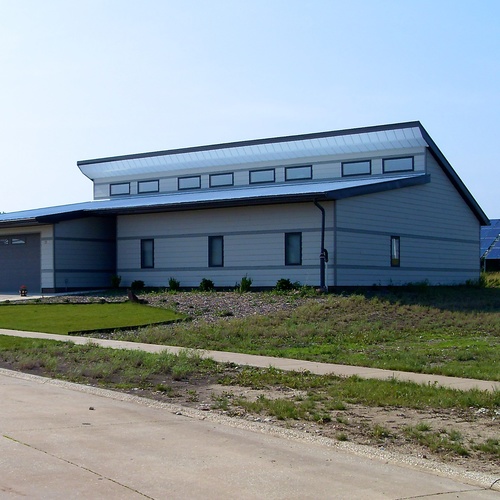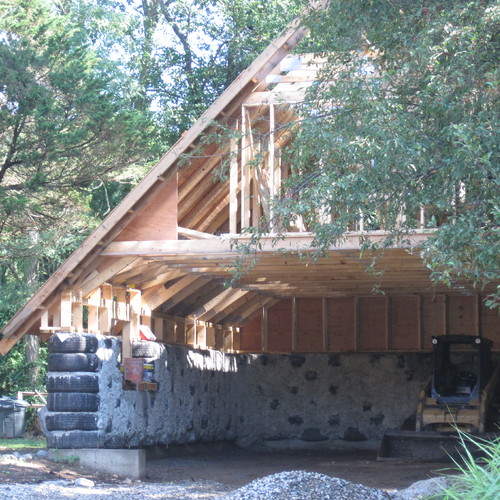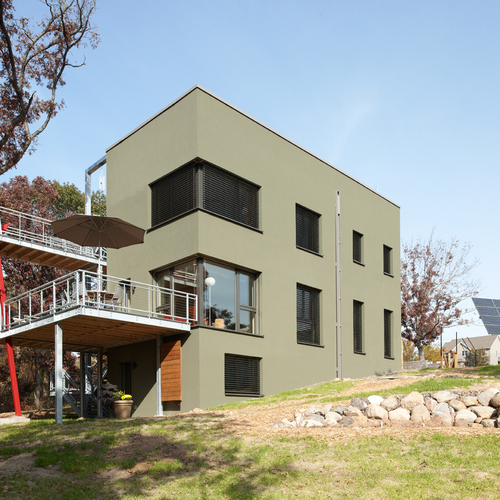
Meet BuildingGreen
(From left): Peter Yost, Brent Erhlich, Alex Wilson, Nadav Malin, Paula Melton, and Tristan Roberts.Unlike most of the blogs we review here, BuildingGreen is not the voice of a single author. Rather, it’s a portal to a broad collection of blogs, news articles, product information, and other posts written by many people.
BuildingGreen is the work of an independent publishing company based in Brattleboro, Vermont, which also publishes the highly respected Environmental Building News and GreenSpec. As the company’s website explains, “The corporate mission of BuildingGreen, Inc. is to facilitate transformation of the North American building industry into a force for local, regional and global environmental protection; for preservation and restoration of the natural environment; and for creation of healthy indoor environments — while promoting the well-being of the company and its employees, owners, and associates.”
Visitors to the home page get a number of choices. There are three major content divisions (BuildingGreen Suite, LEEDuser, and Environmental Building News) plus a number of tabs at the top linking readers to news, green products, and case studies, among other things. Some of the information is free, and some of it is behind a pay wall, accessible only to members.
There is plenty here for those who don’t want to pony up the membership fee. Recent news items covered the split between the International Passive House Institute and the Passive House Institute U.S., the dismissal of Henry Gifford’s lawsuit against the U.S. Green Building Council, and changes in Energy Star labeling for appliances.
Blogs are accessible to non-members, as are summaries of green building case studies. But if you want to dive deeper, or get detailed product information, you’ll need to join.
In this respect, BuildingGreen is not unlike GreenBuildingAdvsior, whose two-tiered structure also offers both free content and content behind a pay wall. No matter what side of the wall you find yourself on, the work is authoritative, thorough, and readable. Its authors include Alex Wilson (the founder of Environmental Building News, now on sabbatical), Nadav Malin, Peter Yost, and Tristan Roberts, among others.
Yes, some of those names are familiar. You’ve seen the work of Wilson, Yost, and Roberts at GreenBuildingAdvisor, too. BuildingGreen and The Taunton Press partnered to build GreenBuildingAdvisor; although the two have since ended their formal business relationship, evidence of that cross-pollination remains.
EBN and BuildingGreen have a very long pedigree, and Alex and his associates have been covering green building and its related fields longer than anyone else in the business.
Here are some excerpts from recent blogs:
New approach for solar thermal systems for cold climates
“Most solar thermal systems installed in cold climates use antifreeze, but Ritter XL Solar is engineering its systems with water. Can a large-scale commercial system survive the cold?
“Ritter XL is doing what few solar thermal manufacturers have dared: creating large-scale solar thermal systems in cold climates running on only water. The company is using its compound parabolic concentrating (CPC) collectors to generate high-temperature water for commercial, multifamily, district heating, and other applications that have high demand for hot water. Distributed in the U.S. by Regasol USA, a subsidiary of the German company Ritter Gruppe, these complex systems require precise engineering and controls but can provide supplemental solar hot water in cold climates without freezing.”
On paying for energy inefficiency
“The strategy of living with inefficient homes and cars, and then looking to retirement accounts and paychecks to pay for that inefficiency appears more and more questionable. And I have some numbers to prove it.
“An astute analysis was recently posted to GreenBuildingAdvisor.com by Ted Clifton, a builder, and the founder of Zero-Energy Plans (zero-energyplans.com) in Washington. The numbers Ted put together are pretty straightforward, but the conclusions might be startling to many people, particularly those living in a home with significant energy bills, while also thinking about retirement.
“Clifton quotes statistics kept by the U.S. Department of Commerce, which has been keeping track, since 1974, of the price that consumers pay for energy. Although energy prices are very volatile, and are different for various energy sources (oil goes up and down, while trending up over time, while electricity is more stable, while still going up), Clifton found that the average annual increase for overall energy prices including natural gas, heating oil, and propane, has been 6.33%.
“According to Ted, ‘By comparison, the Consumer Price Index, used by the government to calculate increases to your Social Security check, has only risen at an annual rate of just under 1.54% during that same period. It is clear just from looking at these two numbers that if you are trying to use your Social Security check to pay for your energy use, you will be falling behind by about 4.8% per year.’”
The appeal of white cedar shingles
“White cedar shingle siding protect a building from the elements, have a small environmental footprint, are easy to maintain, and they look good.
“After a long summer of too much rain followed by too much heat, I am finally able start painting the clapboards on our house. The house desperately needs it, but I don’t look forward to the prepping, scraping, caulking, and eventual painting. It got me thinking: what siding would I choose if I were starting over with a new home? (Hey, I can dream.) The answer was simple for me … white cedar shingles.
“White cedar is also moisture-resistant. It has a naturally low moisture content, yet it does not absorb moisture like most other wood. And once the shingles dry, they ‘stabilize’ to resist cracking and splitting. Untreated, they only need to air dry, so no kiln drying is necessary, saving the manufacturing energy that other woods typically require.”
Reflections from Robert Riversong
“In his seminal 1963 book Never Cry Wolf (made into a Disney movie in 1983), Canadian author Farley Mowat wondered how the Arctic Inuit people could live in caribou skin tents full of holes, until he realized that their primary shelter was the double-layer furred skin clothing they wore year round. Their shelters — summer tents and winter igloos — were merely secondary shelters to offer a modicum of protection from the elements while still retaining a deep connection to the environing landscape which contained and sustained them.
“Mowat’s other discovery, which helped turn worldwide public opinion from the myth of the “big, bad wolf” toward a deep and abiding respect for this highly social and playful animal which is at the core of the Arctic ecosystem, was that ‘We have doomed the wolf not for what it is, but for what we deliberately and mistakenly perceive it to be — the mythological epitome of a savage, ruthless killer — which is, in reality, no more than the reflected image of ourself.’
“The mindset which perceived the wolf as monster was the same paradigm which understood nature as wild and mean and something that needed to be tamed, controlled, and isolated from our daily ‘civilized’ lives. This foundational myth of civilization, which led us to build fences to keep wild nature out of our domesticated spaces, also resulted in the incarceration of humanity in an entirely self-reflective world detached from the ground of our being.
“The more we denied the wildness of our own selves, the more we projected our suppressed carnality onto such creatures as wolves, and the more thoroughly we enclosed ourselves within both philosophical and material cages.”
Weekly Newsletter
Get building science and energy efficiency advice, plus special offers, in your inbox.















0 Comments
Log in or create an account to post a comment.
Sign up Log in